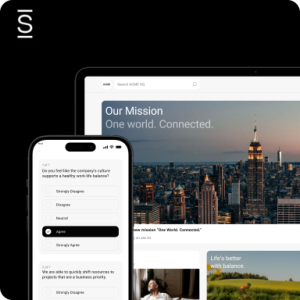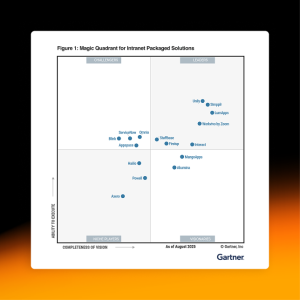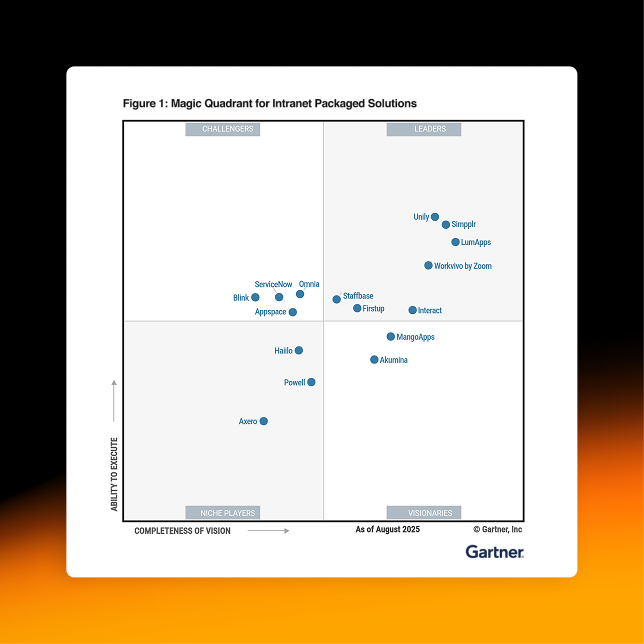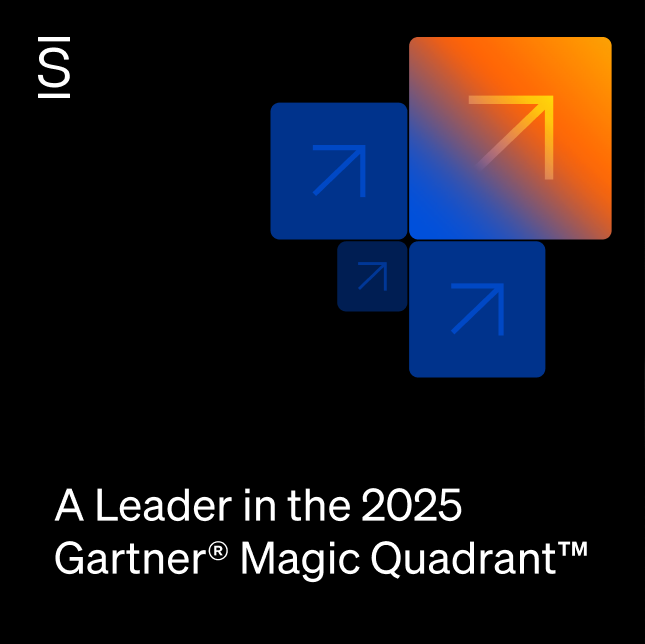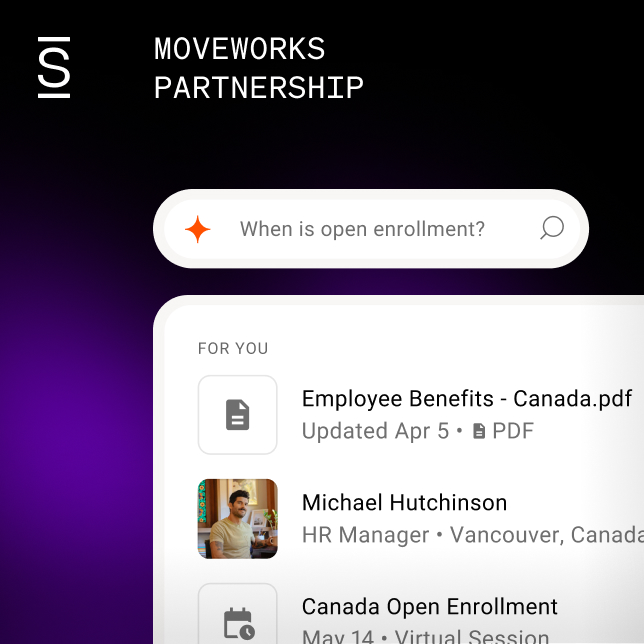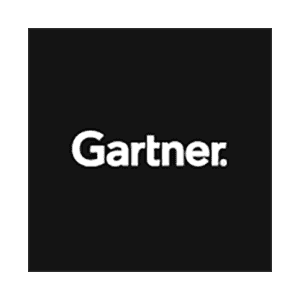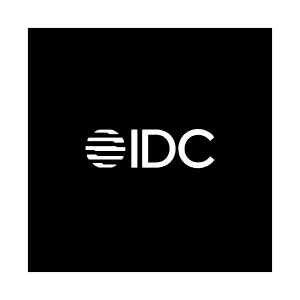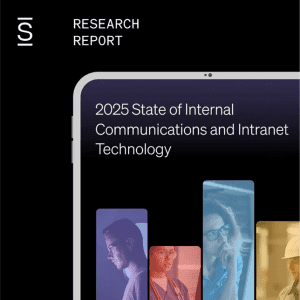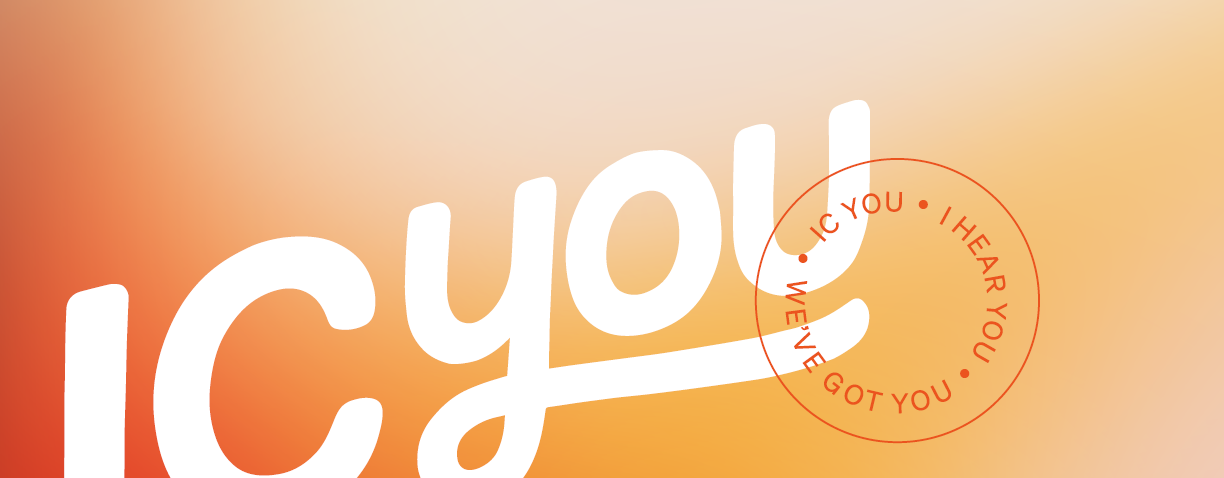Your employees are drowning in disconnected tools — Slack for messaging, SharePoint for files, BambooHR for benefits, Culture Amp for surveys — while your intranet sits largely unused. The problem isn't that you need more tools. A modern intranet should be paired with an employee experience platform to unify everything your workforce needs in one place.
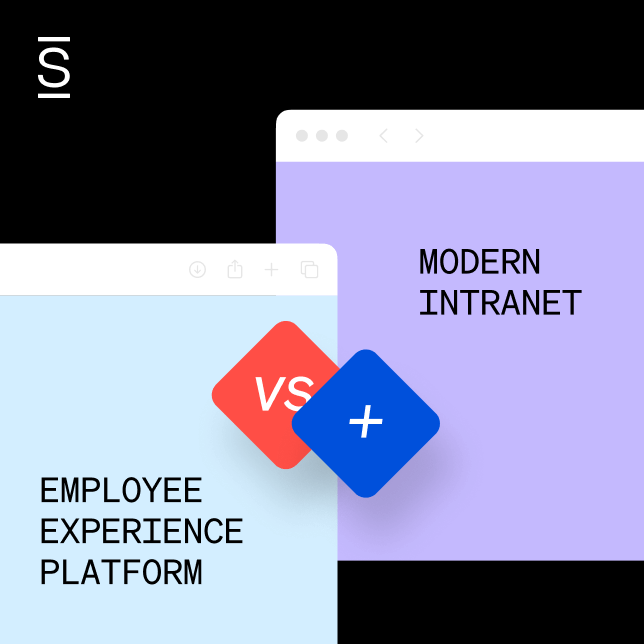
Employee experience platform vs. modern intranet: why you need both
- 1 Modern intranets are an essential foundation
- 2 How employee experience platforms are different
- 3 6 core pillars of employee experience platforms
- 4 Protect your investment with configuration and extensibility
- 5 4 use cases showing how EXPs transform intranet foundations
- 6 A unified approach: modern intranet + employee experience platform
- 7 When to enhance your intranet with EXP capabilities
- 8 EXPs are the future of digital workplaces
- 9 Why Simpplr delivers the best of modern intranets and EXPs
The days of basic intranet “bulletin boards” are over. Today’s workforce expects easy access to documents, resources, and communication from their company intranet. But even modern intranets can’t solve the bigger challenge: employees are juggling countless apps and tasks across fragmented systems that don’t talk to each other.
That’s where an employee experience platform (EXP) comes in. It’s a unified, AI-powered system that amplifies everything your modern intranet already does well — plus adds engagement tools, analytics, and personalization that turn information sharing into seamless employee experiences. Enhancing your intranet with EXP capabilities is a strategic evolution toward a unified digital workplace that eliminates tool fragmentation.
Modern intranets are an essential foundation

A modern intranet is the bedrock of digital workplace communication. Today’s modern intranets play four mission-critical roles: delivering company news, hosting document repositories, providing team directories, and enabling basic audience segmentation for content delivery.
According to Simpplr’s 2024 State of the Intranet report, nearly two-thirds of organizations have a modern intranet. When these systems work well — with good UX, mobile access, and clear governance — they provide a centralized place to find critical updates, essential resources, and tools employees need every day.
But the modern employee expects more than basic access to information. They want personalized experiences, instant support, peer recognition, and seamless workflows throughout their workday.
Expanding the digital toolkit
To meet these evolving expectations, IT adds collaboration platforms (Slack, Teams), HR implements workforce management systems (Workday, BambooHR), Internal Communication teams deploy recognition platforms (Bonusly, Kudos), and leadership invests in feedback tools (Culture Amp, Glint). Each department finds solutions that work for their specific needs.
The challenge is that these tools don’t usually work in tandem. Employees end up juggling multiple interfaces, switching between systems, and struggling to find what they need across disconnected platforms.
The hidden cost of tool fragmentation
Beyond disruptions to the digital employee experience, organizations face deeper systemic issues when bringing in problem-specific tools.
The negative impacts of a fragmented tech stack include:
- Siloed knowledge and stale content: Without unified content governance, information becomes scattered across platforms and employees struggle to find current policies and documents.
- Complex tech management: IT teams juggle multiple vendors, broken integrations, and security protocols across systems, increasing costs and risks.
- Analytics blind spots: Basic page-views dashboards don’t reveal employee engagement across fragmented platforms.
- Limited personalization and cultural alignment: When content doesn’t take into account differing language, culture, or role-specific needs, certain employees may feel disconnected.
Organizations with average-quality intranets are 2.5x more likely to see decreased profitability and 50% less likely to report productivity gains (Simpplr’s 2024 State of the Intranet report).
A fragmented digital workplace frustrates employees and burdens IT teams. Despite all these additional tools, leadership still struggles to measure ROI and improvements in company culture across scattered investments. This is why organizations are turning to employee experience platforms — not to replace their intranet but to add the much-needed intelligent layer that connects everything together.
How employee experience platforms are different
An employee experience platform (EXP) is fundamentally different from a modern intranet. While intranets connect people to information, EXPs are AI-powered systems that connect people to each other, their work, and the moments that matter most in their careers.
The distinction is crucial: your intranet is a channel for publishing content. An EXP brings together tools for increasing engagement, automating workflows, and capturing analytics that help you create a more unified employee experience.
EXPs ensure information is understood, acted on, and felt. They go beyond making information available to driving behavior, culture, and clarity at scale.
EXPs amplify your intranet foundation
At its core, an EXP still does everything a modern intranet does — hosting news, documents, and basic team directories. But then it adds the intelligence layer that transforms static information sharing into dynamic employee experiences. It unifies newsletters, surveys, employee recognition, and policies in one easily accessible place.
An EXP spans the entire employee journey from onboarding through performance reviews and career development. Most importantly, it prevents information from splintering across systems. Employees get a consolidated view of everything they need.
Bottom line: If a modern intranet solves “Where’s that benefits brochure?” an EXP solves “What do I need to do next, who can help me, and how am I doing?”
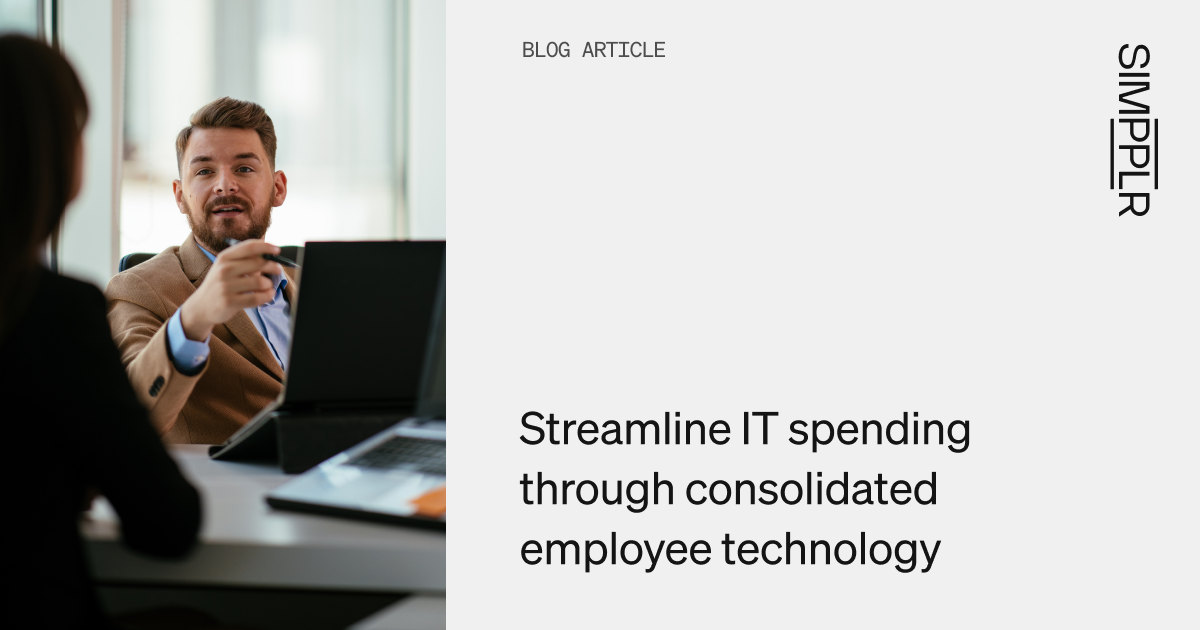
6 core pillars of employee experience platforms
Every comprehensive EXP addresses six essential capabilities that go far beyond what standalone tools can deliver
1. Communications and targeted outreach: AI-powered personalization ensures the right messages reach the right people at the right time according to role, location, and department.
2. Knowledge management and enterprise search: Intelligent search spans every connected platform to surface the most relevant, up-to-date information instantly, providing context-aware answers and relevant next actions.
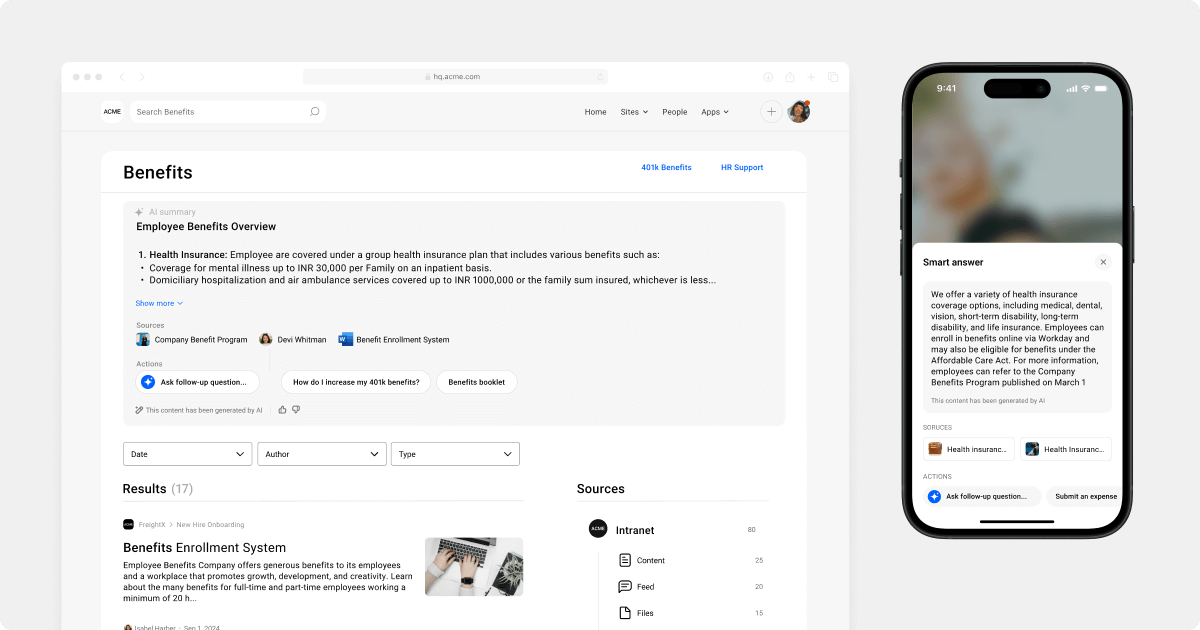
3. Cross-functional collaboration: Cross-functional employee forums and communication tools foster knowledge sharing and social learning, which is essential for distributed teams.
4. Employee engagement and recognition: Pulse surveys and real-time sentiment tracking captures employee feedback for actionable insights, while recognition and rewards boost engagement.
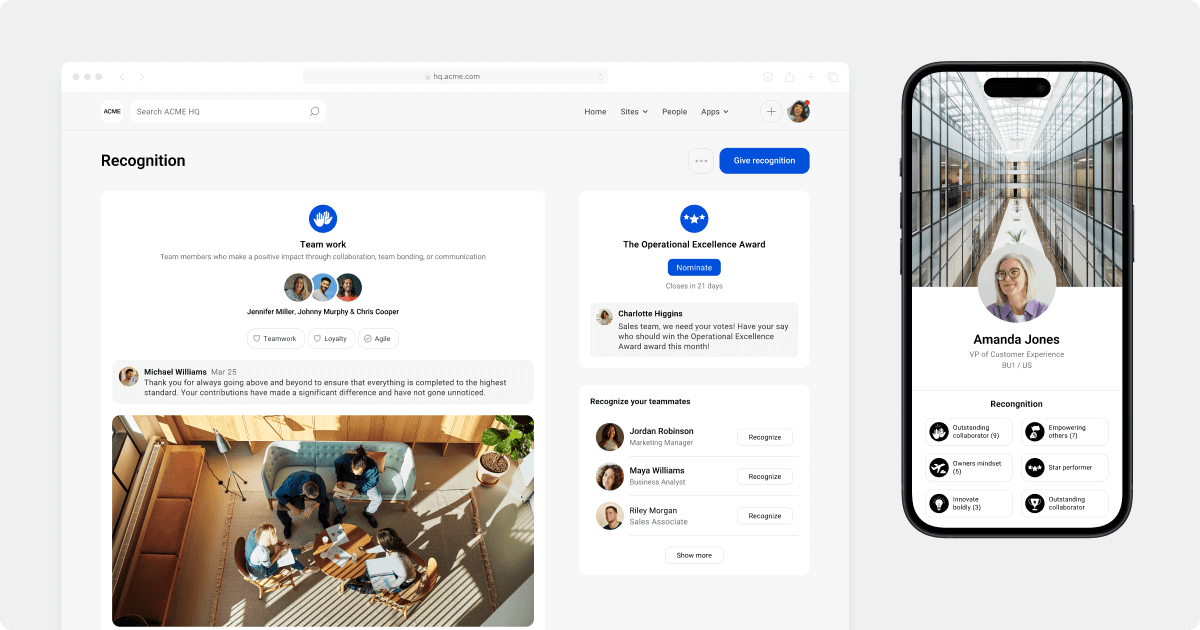
5. Employee services and enablement: Streamlined HR self-service, IT help-desk ticketing, and other automated workflows save employees time and reduce administrative friction.
6. Analytics and actionable insights: Predictive and prescriptive insights help leadership understand not just what’s happening but also what to do next to keep initiatives on track and employees aligned with company goals.
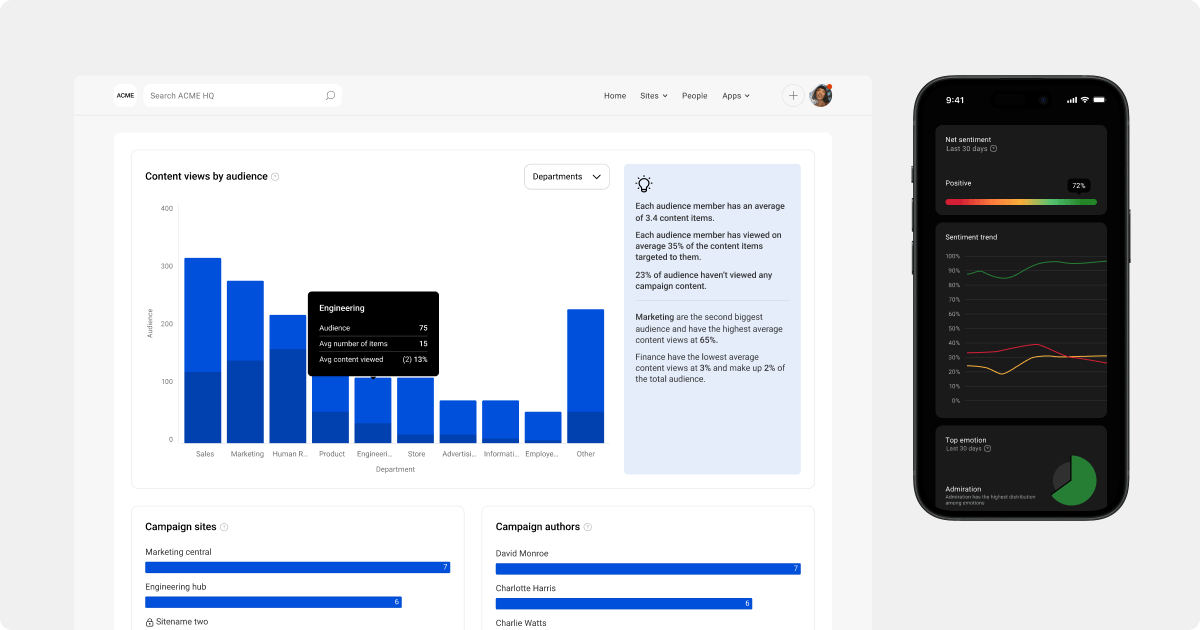
These six core features together transform the EXP into an active “people platform.” As a result you get a more engaged, informed, and productive workforce.
Protect your investment with configuration and extensibility
Beyond these essential capabilities, what makes EXPs a strategic choice is their ability to evolve and scale with your organization. The best EXPs feature highly configurable and extensible architecture that grows alongside your business.
As you acquire new systems, they integrate seamlessly without platform overhauls. When your teams expand, AI automates increasingly complex workflows. As workforces become more distributed, predictive insights help you manage engagement and productivity effectively.
Smart workflows through seamless integration
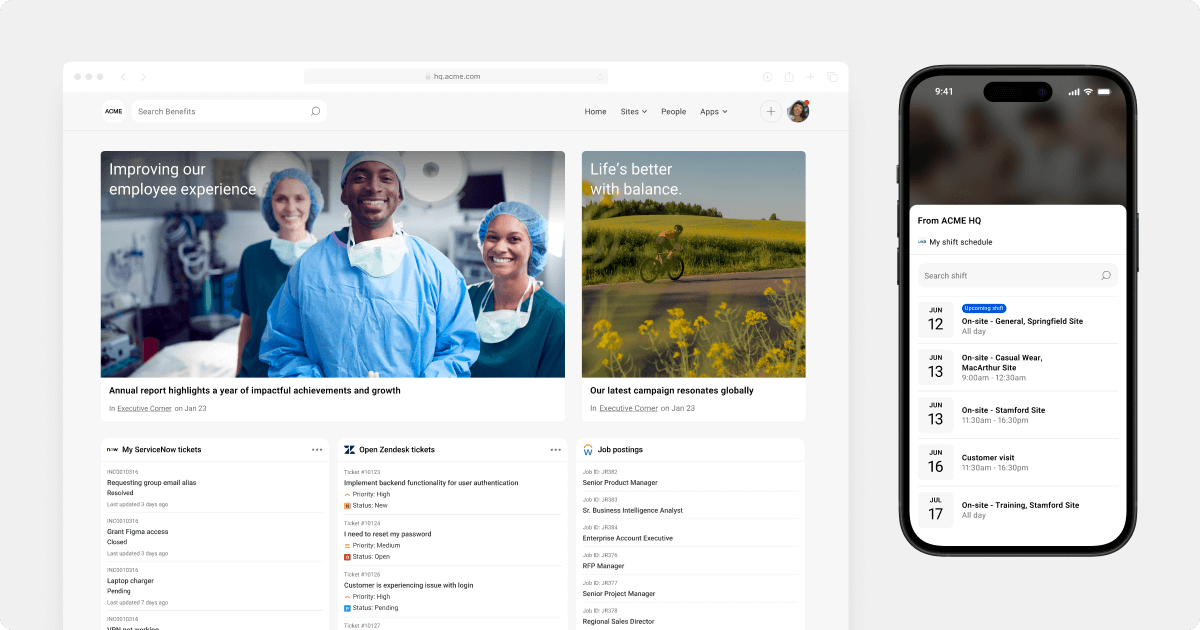
Here’s a critical difference between an EXP and a modern intranet: EXPs create bidirectional workflows that let employees complete tasks across systems without switching between systems. For example, instead of displaying static HRIS information, an EXP enables employees to update their profiles, request time off, and access benefits directly within their daily workflow.
EXPs provide the communication, resources, and tools employees need wherever they work, whether that’s Slack, Teams, or mobile apps. Employees can see project updates, complete tasks, approve requests, and collaborate on projects — all on one platform for a unified and contextualized experience.
AI-driven personalization and automation
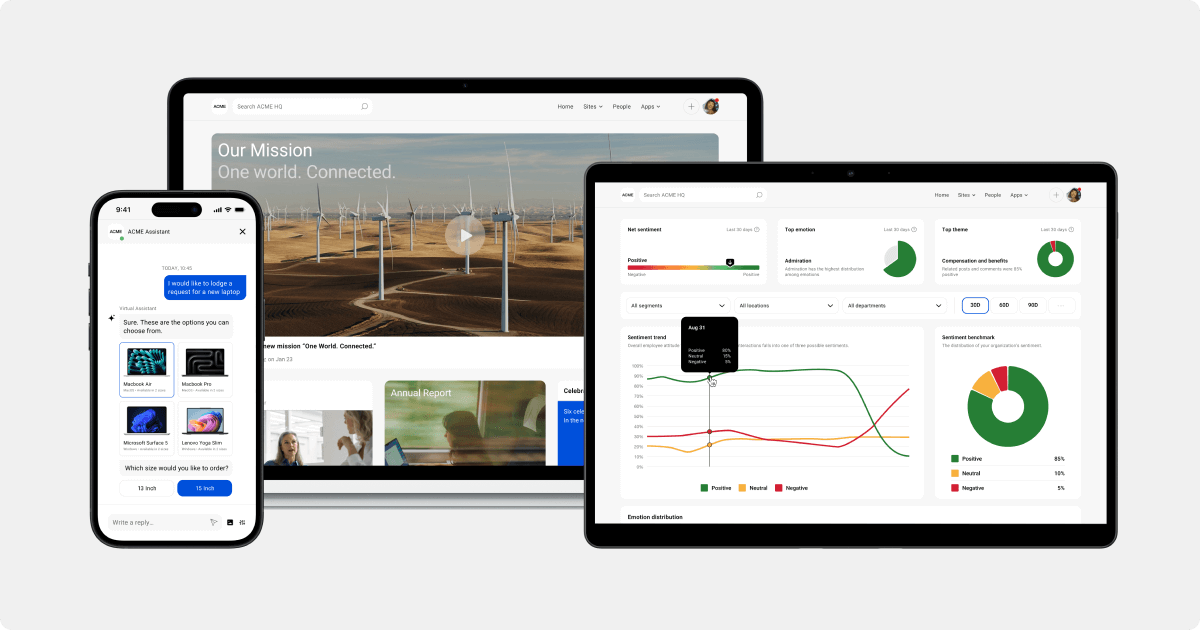
The most advanced EXPs embed AI throughout the platform, creating systems that understand your organization as well as individual employee behaviors.
Beyond smart content curation, AI within an EXP handles three critical functions:
- Scalable personalization: Custom homepages and content recommendations based on role and behavior
- Workflow automation: Automatic scheduling, routing, and task management
- Predictive insights: Early warning systems for engagement dips and potential attrition
EXP integrations and AI ensure your technology stays a step ahead of future needs. As your business grows and workforce needs change, your EXP evolves alongside you. This makes it a strategic investment that pays off in reduced implementation and maintenance costs over time, compared to a platform that can swiftly become obsolete.
4 use cases showing how EXPs transform intranet foundations

The best way to understand EXPs is by seeing how they amplify your existing intranet in day-to-day scenarios. Below are four common workplace challenges where organizations typically start with their intranet foundation, along with how added EXP capabilities create more seamless digital employee experiences.
1. From basic HR onboarding to personalized employee journeys
Intranet foundation: New hires access welcome pages, policy documents, and basic checklists through your intranet’s document management system.
EXP amplification: The platform detects each user’s role and creates personalized onboarding dashboards. A sales associate sees CRM training and territory maps, while a product designer gets design system access and mentor matching — all building on your existing welcome content.
Automated workflows guide new hires through next steps while giving HR real-time visibility into progress, turning your static onboarding materials into dynamic, role-specific experiences.
2. From IT-enabled document search to intelligent knowledge management
Intranet foundation: Employees find policies, procedures, and resources through your intranet’s search and document repositories.
EXP amplification: AI-powered enterprise search spans your intranet content plus connected business systems, presents the most relevant results, and offers suggested next steps. Additionally, an embedded chatbot can answer questions such as “How do I reset my VPN?” using your existing IT documentation, deflecting routine tickets.
Organizations that switch to an employee experience platform empower employees with self-service to easily find information. This saves time, slashes costs, and reduces IT tickets.
3. From company announcements to engaged communication
Intranet foundation: Internal comms teams distribute company news and announcements through your intranet’s news feed.
EXP amplification: Communication becomes a conversation. New hires see CEO welcome videos, while department heads get strategy deep-dives. Real-time analytics show not just who viewed content but also sentiment and engagement levels. Communication evolves from broadcasting to meaningful two-way dialogue.
4. From information sharing to culture building
Intranet foundation: Company values, team directories, and organizational updates live in your intranet’s community spaces.
EXP amplification: These spaces become active culture hubs where recognition flows through social feeds and employees join interest-based communities. Your static values pages transform into living, breathing culture experiences.
Let’s look at how EXP enhances your modern intranet foundations to give you better ROI.
A unified approach: modern intranet + employee experience platform
| Capability | Intranet foundation | EXP enhancement | Combined result |
|---|---|---|---|
| Communications | Homepage banners, basic news feed, departmental targeting | AI-driven personalization, multichannel delivery, real-time feedback | Targeted messages reach the right people with measurable engagement |
| Knowledge management & smart search | Document repositories, basic keyword search, manual tagging | Centralized content, enterprise search, auto-tagging, content lifecycle management | Single source of truth with search that understands context and delivers instant answers |
| Employee engagement | Comments on posts, basic feedback forms | Recognition feeds, sentiment analysis, pulse surveys, community building | Continuous measurement with proactive engagement insights |
| Analytics | Page views, log-in rates, basic usage metrics | Predictive insights, behavior analysis, attrition risk | Actionable intelligence that drives strategic decisions |
| Integrations | SSO, basic API connections | Bidirectional workflows, embedded actions, extensible architecture | Unified system where employees complete work without context-switching |
| Mobile experience | Responsive design, mobile-friendly interface | Native app, offline access, push notifications, location-based content | Seamless experience across all devices and work environments |
| Security and governance | Role-based permissions, manual updates, basic admin controls | Industry compliance, enterprise-grade security, audit trails | Continuous compliance with reduced administrative overhead |
Each use case demonstrates that EXPs don’t replace your intranet capabilities — they enhance them with intelligence, personalization, and workflow automation. Your intranet investment remains valuable while becoming exponentially more effective.
When to enhance your intranet with EXP capabilities
Your modern intranet may be serving your organization well. Many companies find that robust intranet platforms perfectly meet their communication and information-sharing needs. But if you’re experiencing rapid growth, managing distributed teams, or hearing requests for more personalized employee experiences, it might be time to consider adding EXP capabilities.
The good news is you don’t have to choose between an intranet or EXP. The best employee experience platforms include modern intranet capabilities as their foundation.
Then they add to this foundation:
- Advanced targeting and personalization using AI and user profiles
- Integrated communities and recognition in the same interface
- Robust analytics with sentiment analysis and predictive insights
- Broad integrations and automation across your tech stack
In short, when you evaluate vendors, look for an EXP that includes a modern intranet as its foundation rather than seeing them as mutually exclusive options.
Key questions to guide your decision to upgrade your intranet to an EXP
When evaluating whether migrating to an EXP is right for your organization, start by considering these questions:
- Scale and complexity: Are you managing a large workforce across multiple locations or time zones? Do different employee groups need different experiences (e.g., frontline vs. desk-based workers)? Are you planning rapid expansion over the next 12–24 months?
- Experience expectations: Are employees asking for personalized content and recommendations beyond basic news and policies? Do you need real-time sentiment tracking, adoption metrics, and predictive insights rather than just page views?
- System-building: Do you need to connect to Workday, ServiceNow, Microsoft 365, Salesforce, and other essential business systems right out of the box? Do you need APIs or event streams to feed data from HRIS, CRM, ERP, or other core systems?
- Operational efficiency and total cost of ownership: Is your team managing multiple separate tools for communication, recognition, and analytics? Would consolidating these tools reduce vendor management and licensing costs? How many IT hours and internal resources can you dedicate to implementation? Will your EXP vendor provide migration support?
If most answers were no, your modern intranet investment may continue serving you well for centralized teams with straightforward communication and document storage needs.
But if you answered yes, strategic EXP enhancement makes sense for your organization. You’re likely managing diverse, distributed teams that want personalized experiences beyond what standalone intranet capabilities can deliver. You’re looking to consolidate tools and reduce vendor complexity, while improving engagement with data-driven insights.
Ready to move forward with an EXP? Here’s how to approach the implementation strategically.
EXP implementation roadmap for HR leaders
Phase 1: Strategic assessment (2-4 weeks)
- Finance: Evaluate current tool spend vs. consolidated platform ROI
- HR: Assess employee journey pain points and engagement gaps
- IT: Review integration requirements and compliance needs
Phase 2: Stakeholder alignment (1-2 weeks)
- Internal comms: Align on communication strategy and content governance
- Business leaders: Capture department-specific needs and growth projections
- Change management: Plan employee adoption and training strategy
Phase 3: Platform evaluation and selection (2-3 weeks)
- Prioritize vendors that include robust intranet capabilities as their foundation
- Focus on extensibility and AI-driven functionality
- Validate integration depth with critical business systems
The goal is to find an EXP that provides a strong modern intranet foundation along with an intelligent layer that maximizes your investment while meeting your organization’s current and future needs.
EXPs are the future of digital workplaces
Organizations with successful digital workplace strategies don’t choose between an intranet and an EXP. Instead, they recognize that modern intranets provide a crucial foundation, while EXPs boost productivity and engagement.
Intranets are essential for news delivery, document management, team directories, and basic communication. EXPs build on this foundation with AI-driven personalization, predictive insights, and workflow automation, transforming static information sharing into dynamic, personalized experiences.
Organizations that implement integrated EXPs see 90%+ adoption rates, faster onboarding, reduced IT tickets, and measurable improvements in employee engagement.
Let’s explore how Simpplr delivers both modern intranet excellence and intelligent employee experience features in a unified platform.
Why Simpplr delivers the best of modern intranets and EXPs
Simpplr One is purpose-built for organizations that want a robust modern intranet enhanced by EXP intelligence. The platform serves as a digital HQ for news, policies, and team directories but with expanded AI and integration capabilities.
AI that works behind the scenes
Simpplr AI operates through distinct but integrated capabilities that transform how employees find information and get work done.
- AI Assistant for instant employee support: Ask “Where’s the latest expense policy?” and get immediate answers while deflecting routine IT and HR tickets
- Enterprise search across all systems: One search that spans your intranet, SharePoint, Google Drive, Salesforce, and 200+ platforms with results by relevance and recency
- Automated content governance: AI continuously monitors content, flagging outdated policies, and surfacing newer versions without manual oversight
- Personalized experience engine: Recommended training, recognition opportunities, and tailored homepages based on role and behavior
Simpplr AI eliminates the frustration of hunting for information across disconnected platforms while ensuring everyone gets relevant, current content regardless of location or work schedule.
Integrations that connect workflows
Simpplr connects to Workday, ServiceNow, Microsoft 365, Salesforce, and 200+ systems with bidirectional integrations that let employees complete tasks without jumping between apps. The mobile-first platform also extends into Slack, Teams, and other communication channels to reach employees wherever they work.
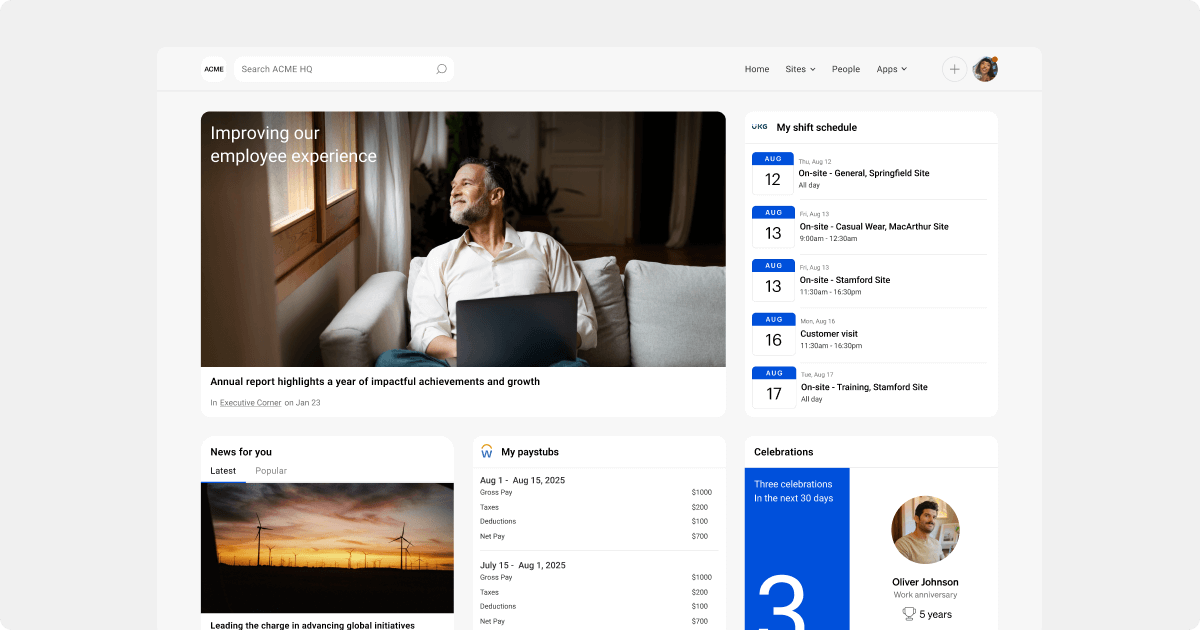
Why choose Simpplr as your EXP vendor? With 4.7+ ratings across review platforms and zero implementation failures, Simpplr stands as the clear category leader. Organizations like Pluralsight complete migrations in under 30 days, while others achieve 90% employee adoption and 99% global engagement. Read more customer success stories to see how Simpplr transforms the employee experience for customers around the globe.
These results happen because Simpplr unifies modern intranet excellence with EXP intelligence in a single platform. The AI roadmap ensures continuous evolution without disruption.
Ready to see how Simpplr brings an intranet and EXP together? Request a demo today.
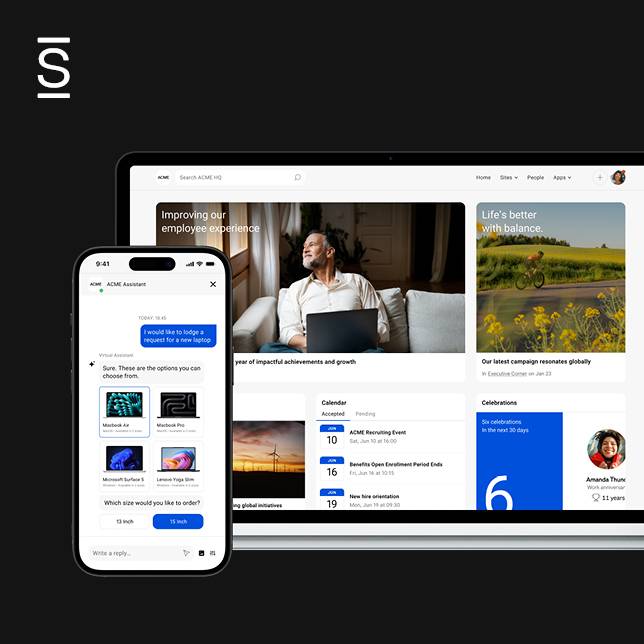
Watch a 5-minute demo
See how the Simpplr employee experience platform connects, engages and empowers your workforce.
- #1 Leader in the Gartner Magic Quadrant™
- 90%+ Employee adoption rate


